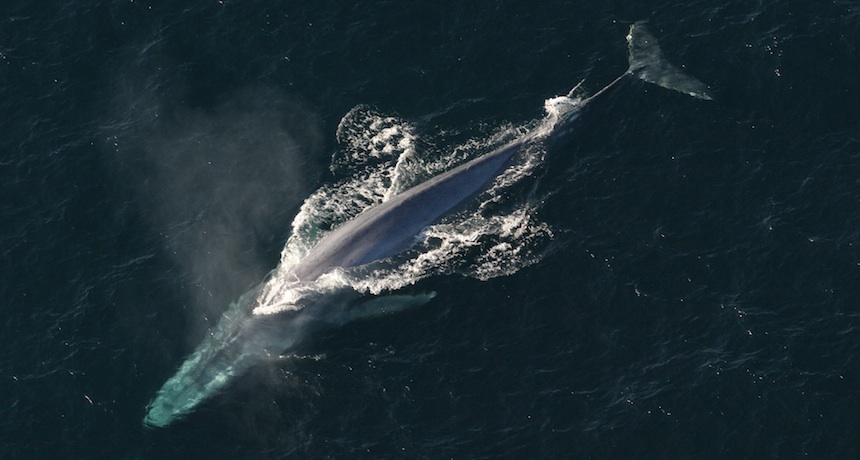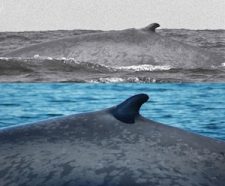A whale of a journey
A blue whale named Isabela has been caught making a 5,200-kilometer (3,200 mile) trek across the Pacific

Blue whales are the largest creatures on Earth, but they have proven elusive to scientists studying them. A new study finds hints that one group of the animals may migrate thousands of kilometers through the Pacific.
NOAA
The blue whale is the largest animal alive today. And one of these whales has been caught making an appropriately big journey through the South Pacific. The whale was first recorded near the Galapágos Islands, west of Costa Rica. Years later, that same whale was photographed off the coast of Chile in South America, a new study reports. The two spots are separated by some 5,200 kilometers (3,200 miles). That means it swam farther than the distance between New York and Los Angeles.
Scientists reported the whale’s mammoth trek June 11 in Marine Mammal Science.
Blue whales are surprisingly difficult to study. They are found in all the world’s oceans but live in deep waters. So there are few places where they can be found easily. Moreover, the species was nearly driven extinct by whaling a century ago. Populations are recovering. But because there are so few of the animals, this species is still considered endangered.
To aid the species’ recovery, scientists need to know more about where they travel, explains study leader Juan Pablo Torres-Florez. He is a whale researcher at Austral University of Chile in Valdivia. Understanding the whales’ migrations could help guide conservation measures, he says.

One blue whale may look like any other to the untrained eye. But each animal has a distinctive pattern of spots. “We use those patterns as the fingerprint of blue whales,” Torres-Florez says. To make the comparison job easier, scientists focus on the area around a whale’s dorsal fin, which is on its back. “Comparing those patterns we are able to identify if a whale is the same whale we saw in different places or if the same whale is sighted during different years in the same place,” he says.
One whale showed up in the Galápagos on November 6, 1998, among a group of nine animals. It appeared again off of Chile on February 23, 2006. The photographs and the DNA matched. The whale was nicknamed “Isabela,” after both Torres-Florez’s daughter and the Galápagos island near to where this animal had been sighted. The whale’s journey was at least 5,200 kilometers (3,200 miles). That makes it the longest north-south journey ever recorded for a member of her species.
Isabela is probably not the only blue whale to travel so far, the researchers say. Members of her population likely migrate regularly from Chile to the Galápagos. In summer months, Torres-Florez notes, waters in the far southern Pacific are loaded with krill — tiny crustaceans on which these whales dine. But that food disappears in winter. That’s when the whales travel north to warm, tropical waters near the Galápagos.
There, “instead of feeding, the whales breed,” he says. Scientists don’t yet know why whales prefer to breed in tropical locations. But the ocean there may be warmer and calmer and have fewer orcas that would prey on baby blue whales, Torres-Florez says.
Power Words
(for more about Power Words, click here)
conservation The act of preserving or protecting something. The focus of this work can range from art objects to endangered species and other aspects of the natural environment.
data Facts and statistics collected together for analysis but not necessarily organized in a way that give them meaning. For digital information (the type stored by computers), those data typically are numbers stored in a binary code, portrayed as strings of zeros and ones.
DNA (short for deoxyribonucleic acid) A long, double-stranded and spiral-shaped molecule inside most living cells that carries genetic instructions. In all living things, from plants and animals to microbes, these instructions tell cells which molecules to make.
dorsal The back of something, usually an animal.
endangered An adjective used to describe species at risk of going extinct.
extinct An adjective that describes a species for which there are no living members.
Galápagos Islands in the Pacific Ocean that belong to Ecuador and are located some 1,000 kilometers (620 miles) west of the South American mainland. Charles Darwin’s visit to the islands in 1835 and his observation of unusual animals on them inspired his theory of evolution.
krill Tiny crustaceans that live in the ocean and are the main food source of some whales.
migration (v: to migrate) Movement from one region or habitat to another, especially regularly and according to the seasons.
orca A large species of black-and-white dolphin. Also known as the killer whale.
population A group of individuals from the same species that lives in the same area.
prey (n.) Animal species eaten by others. (v.) To attack and eat another species.
tropics The region near Earth’s equator. Temperatures here are generally warm to hot, year-round.
whale A common, but fairly imprecise, term for a class of large mammals that lives in the ocean. This group includes dolphins.
whaling The business of hunting whales. The practice reached its peak in the early 20th century and nearly drove many species extinct.







